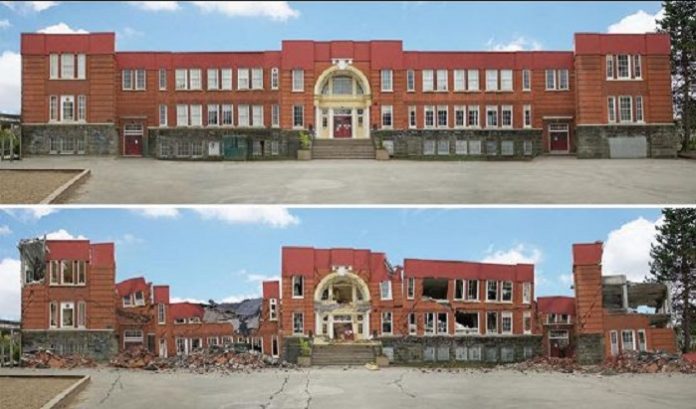SEISMIC engineers and psychologists from the University of British Columbia teamed up with a visual artist to create the image above, which shows what a Vancouver elementary school would look like after a major earthquake. Then, the team tested whether the image would be more effective than statistics in helping people appreciate the risk posed by a major earthquake.
They presented their findings, recently published in the journal Collabra: Psychology, on Friday at the Behavioural Insights in Canada conference in Vancouver. We spoke with Iris Lok, a UBC PhD student in social psychology and the study’s lead author, about the research.
What was the motivation behind this study?
When we started this research, my thesis advisor, Dr. Elizabeth Dunn, was getting her son enrolled in kindergarten. She was troubled by how many kindergarteners in B.C. would be heading off to schools that were expected to collapse during a major earthquake. We wanted to figure out how we could harness our knowledge of human psychology to increase public awareness of this issue.
What existing knowledge about risk perception did you bring to the study?
To help people think about risks like earthquakes, the government typically provides abstract, quantitative information such as statistics. But people often make decisions about risks by relying primarily on their gut feelings. This suggests that people might be more likely to care about earthquakes if dry, abstract information were translated into vivid imagery that would affect people on a more emotional level.
How did you conduct the study?
We selected one of the high-risk schools in Vancouver that had yet to receive seismic upgrades, and we obtained information about that school. Using this information, the engineers on our team envisioned what would happen to the school during a major earthquake. Then, our artist brought their vision to life by creating this vivid representation of what the school would look like, based on the best available science. Finally, we conducted an experiment to see whether people would be more motivated to take action after seeing this vivid image compared to the statistics being used by the government.
So you provided information to two different groups in two different ways, and what did you measure?
We invited participants to sign an existing petition for fast-tracking seismic upgrades for B.C. schools. They also completed surveys about their own intentions to prepare for an earthquake and their support for city-level initiatives.
What did you find?
After seeing the school image, 77.3 per cent of participants signed the petition. This was in contrast to the 68 per cent who signed after being shown only statistics. We found the image had little effect on people’s intention to prepare for an earthquake or their support for city initiatives.
How can these findings advance the cause of earthquake preparedness?
Using vivid images to convey scientific information can motivate the public to take action. If we want people in B.C. to take the risk seriously, it may be valuable to show them what familiar public buildings—or even their own homes—might look like after a major earthquake. We see this approach as a valuable part of a broader strategy for motivating people to prepare for earthquakes.
The team members on the study were: Iris Lok, PhD student, UBC; Elizabeth Dunn, professor of psychology, UBC; Evan Eschelmuller, undergraduate student, UBC; Paul Slovic, professor of psychology, University of Oregon; Terje Haukaas, professor of civil engineering, UBC; Carlos Ventura, professor of civil engineering, UBC; Armin Bebamzadeh, research associate, department of civil engineering, UBC; Adam MacKay-Smith, visual artist.










